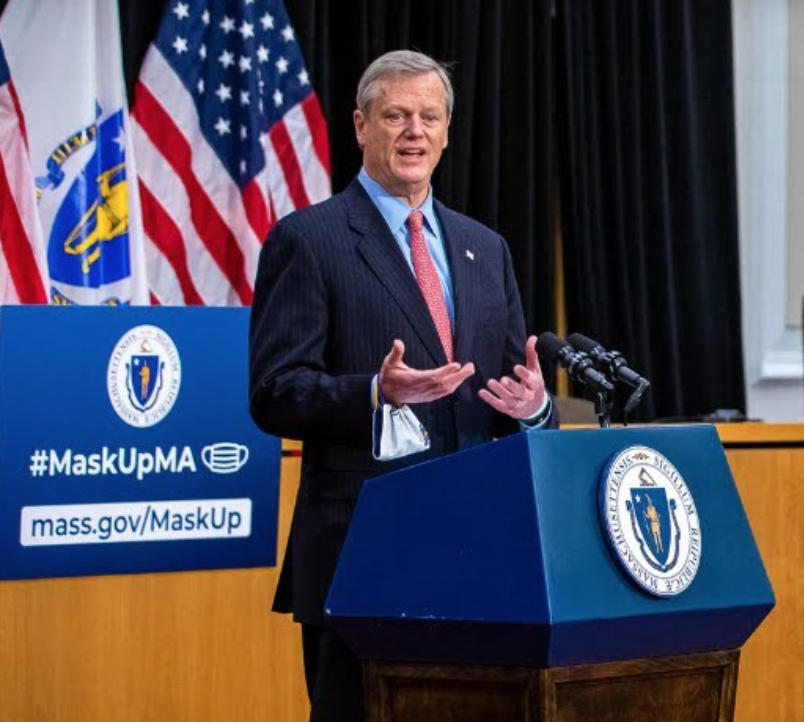
November 6, 2020 by Carol Britton Meyer
During an hour-long press conference today, Gov. Charlie Baker emphasized the importance of adhering to his Nov. 2 COVID-19 orders -- calling them "targeted interventions" -- (https://hinghamanchor.com/gov-baker-issues-new-covid-19-orders/) due to an uptick in COVID-19 cases -- while at the same time placing new importance on children returning to full-time, in-person learning whenever possible.
For communities that are still in the high-risk "red" zone -- where Hingham has remained for three consecutive weeks -- updated new case statistics are expected to be posted by the Massachusetts Department of Public Health later this afternoon -- the hybrid (a combination of remote and in-person) learning model is encouraged. Most Hingham students are currently learning under this model.
School districts are also encouraged to focus on their youngest students for in-person learning, which the Hingham Public Schools has set as a priority.
"A lot has changed since the Department of Elementary and Secondary Education released their guidance for reopening our schools [before the beginning of the school year] and we need to act accordingly," Baker said. "Too many children are learning remotely." At the same time, there's no one-size-fits-all approach to the pandemic, he stated.
Updated Department of Elementary and Secondary Education guidance prioritizes in-person learning for schools throughout the state -- wherever it is physically possible to do so -- with social distancing of at least three feet and other COVID-19 health and safety measures in place.
Commissioner of Elementary and Secondary Education Jeffrey C. Riley said during the press conference that school safety protocols are working and that there has been a "relatively low positivity rate in [Massachusetts] schools."
DESE remains focused on "the well-being of our students, teachers, staff, and their families and is committed to keeping everyone safe while providing an equitable, high-quality learning opportunity" for all students. "We know nothing can take the place of in-person instruction," Riley said.
He also emphasized "the harmful effects of students not learning in [a physical] school."
Increasing free COVID-19 testing is now available to school districts that wish to take advantage of this program in partnership with the Massachusetts Department of Public Health.
The importance of school districts watching for any COVID-19 clusters in order that -- if necessary -- a particular class or an entire school could be temporarily closed to help mitigate the spread was also emphasized.
Baker stated that it's more beneficial to students involved in hybrid or fully in-person learning to go to remote temporarily if necessary than to participate in solely remote learning.
"The time to get kids back to school is now," Riley said. "This virus will be with us for a while. We need to continue to work hard to get as many students returning to in-school learning as possible."
Mary Beth Miotto, a pediatrician and public health advocate based in Massachusetts, encouraged school districts to develop their plans based on the transmission rates within their own schools. "It's important to return more children to school on an in-person or hybrid basis," she said.
Miotto went on to say that "the risks to children working remotely are evident. We are seeing disturbing trends."
She said she has begun to hand out jump ropes to some of her young patients who have gained a lot of weight from spending long periods of time sitting in front of a computer, which she said is also stressful for students. Baker also cited "depression and other negative impacts" students are experiencing from remote learning, in addition to the lack of socialization.
"While we can't downplay the risk of [COVID-19] infection, children who obey the health and safety protocols are likely to be much safer from viral transmissions when in school than they are being out in the community [under remote learning]," Miotto said.
Marylou Sudders, director of Health and Human Services under the Baker administration, explained that current health metrics indicate that transmission of the COVID-19 virus is low in Massachusetts schools, even in communities with a high number of overall COVID-19 cases.
Sudders also said transmissions are more likely to occur in households, while carpooling, and at gatherings "where people have let their guard down" and suggested the avoidance of gathering with others outside your own households and to continue wearing face masks.
With Thanksgiving coming soon, Sudders advised that younger people especially with COVID-19 may by asymptomatic (showing no symptoms). "It's a difficult choice, but choosing to host a virtual Thanksgiving could save a life," she said.
When asked by a reporter following the briefing whether school districts that do not go to in-person learning could be penalized, Baker reiterated that "schools are not spreaders" but that it is "up to the folks on the local level to decide how to respond to that."
According to Riley, each school is considered on an individual basis. "We will address the issue when we feel [a school or school district] is not following state guidance," he said. "To the greatest extent possible we want to get students back to school as soon as possible."
It's "us against the virus," Baker said. "Everyone doing their part can help stop the increase [in COVID-19 cases] and flatten the trend in order to keep our schools open and our economy running."

